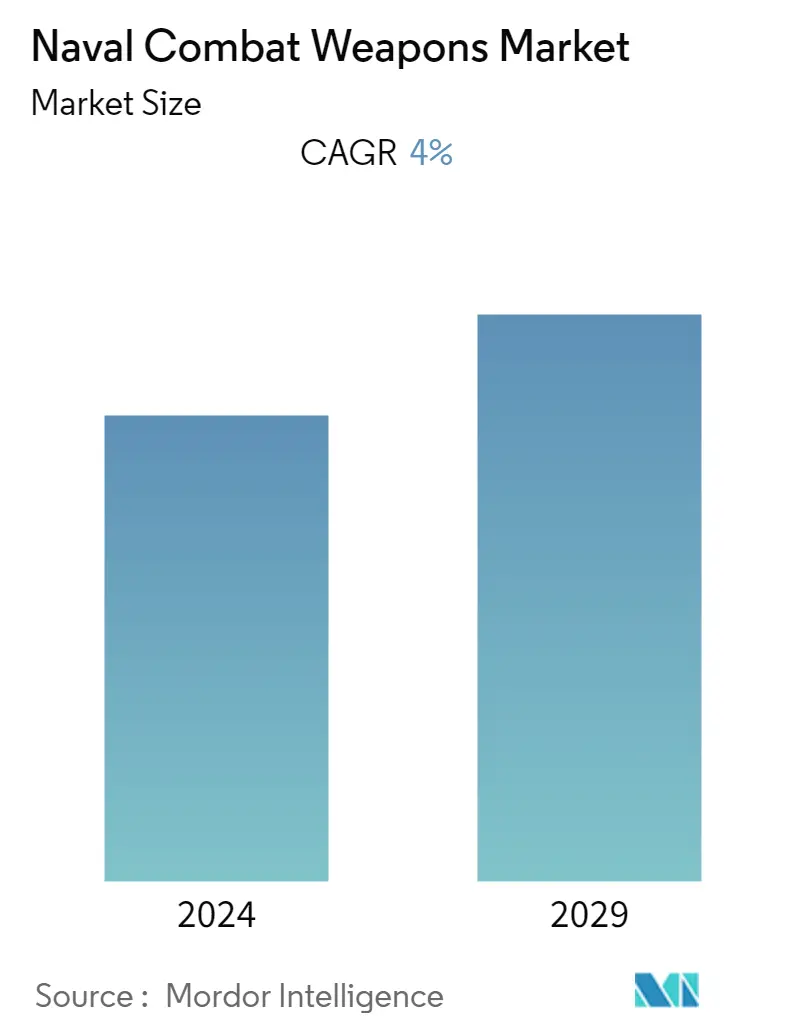
| Study Period | 2019 - 2029 |
| Base Year For Estimation | 2023 |
| Forecast Data Period | 2024 - 2029 |
| CAGR | 4.00 % |
| Fastest Growing Market | Asia-Pacific |
| Largest Market | North America |
| Market Concentration | Medium |
Major Players
*Disclaimer: Major Players sorted in no particular order |
Naval Combat Weapons Market Analysis
The Naval Combat Weapons Market is anticipated to grow at a CAGR of 4% during the forecast period.
The COVID-19 pandemic had a significant impact on the naval combat weapons market because various weapon manufacturing companies took a greater hit regarding production during the pandemic. The emergence of the coronavirus pandemic has led to shutdowns resulting in effects on the supply chain as well as the production of naval combat weapons. Various naval weapon companies witnessed a decline in the number of orders for combat weapons worldwide.
The demand for naval combat weapons is anticipated to experience substantial growth during the forecast period. The growth is attributed to the rising investments from naval combat weapons manufacturers in advanced technologies such as artificial intelligence, the Internet of Things (IoT), and big data analytics in combat weapons. The naval forces are advancing rapidly with the development and integration of high energy laser (HEL) weapon systems with artificial intelligence onto ships to support the ship's self-defense mission.
The significant increase in defense spending and procurement programs by various countries in recent years may propel the growth of the market in the coming years. According to the data released by the Stockholm International Peace Research Institute (SIPRI), world military spending has continued to witness growth in 2021, reaching an all-time high of USD 2.1 trillion. In 2021, the total global military expenditure increased by 0.7% as compared to previous years. Moreover, increasing naval tensions worldwide have led various countries to modernize as well as upgrade their naval fleet with combat weapons which are being developed with new and advanced technologies such as enemy detection by sound and elimination. Such increasing investments in advanced naval weapon technologies for combat purposes will propel the market growth in the coming years.
Naval Combat Weapons Industry Segmentation
Naval combat weapons include all the systems and warfare equipment that are utilized by the naval forces during warfare situations. Various types of combat weapons are utilized by the military to carry out tactical missions and gain a competitive advantage over the enemy.
The Naval Combat Weapons Market is segmented by Platform Type, Application, and by Geography. Based on Platform Type, the market is segmented by Underwater-based Naval Combat Weapons and Surface-based Combat Weapons. Based on Application, the market is segmented into Small Patrol Boats, Large Aircraft Carriers, and Submarines. The report provides market size and forecast and is represented by USD million.
| Underwater-Based Naval Combat Weapons |
| Surface-Based Combat Weapons |
| Small Patrol Boats |
| Large Aircraft Carriers |
| Submarines |
| North America | United States |
| Canada | |
| Europe | Germany |
| United Kingdom | |
| France | |
| Russia | |
| Spain | |
| Rest of Europe | |
| Asia Pacific | India |
| China | |
| Japan | |
| Rest of Asia Pacific | |
| Latin America | Brazil |
| Rest of Latin America | |
| Middle East | United Arab Emirates |
| Saudi Arabia | |
| South Africa | |
| Rest of Middle East and Africa |
Naval Combat Weapons Market Size Summary
The naval combat weapons market is poised for growth, driven by increased defense spending and advancements in technology. The market is recovering from the setbacks caused by the COVID-19 pandemic, which disrupted production and supply chains, leading to a temporary decline in orders. However, the demand for advanced naval combat weapons is expected to rise as manufacturers invest in cutting-edge technologies such as artificial intelligence, IoT, and big data analytics. These technologies are being integrated into new weapon systems, including high energy laser systems, to enhance naval forces' self-defense capabilities. The modernization and expansion of naval fleets, particularly in response to rising global tensions, are further propelling market growth. Countries are increasingly focusing on upgrading their naval capabilities, with significant investments in new submarines and advanced weaponry.
The market is experiencing robust growth in regions like Asia, with China leading the charge due to its substantial military budget and rapid naval expansion. The People's Liberation Army Navy is expanding its fleet, including major surface combatants and submarines, many of which are being equipped with advanced missile systems. This growth is supported by strategic initiatives to modernize the military by 2035, as directed by Chinese leadership. Key players in the market, such as Terma, Leonardo S.p.A, Thales Group, L3 Harris Corporation, and General Dynamics Corporation, are focusing on enhancing their product portfolios with advanced technologies to maintain a competitive edge. Recent contracts, such as those awarded to Raytheon Technologies and MBDA, highlight ongoing investments in naval and aircraft weaponry, underscoring the market's trajectory towards increased sophistication and capability.
Naval Combat Weapons Market Size - Table of Contents
1. MARKET DYNAMICS
- 1.1 Market Overview
- 1.2 Market Drivers
- 1.3 Market Restraints
-
1.4 Porters Five Forces Analysis
- 1.4.1 Threat of New Entrants
- 1.4.2 Bargaining Power of Buyers/Consumers
- 1.4.3 Bargaining Power of Suppliers
- 1.4.4 Threat of Substitute Products
- 1.4.5 Intensity of Competitive Rivalry
2. MARKET SEGMENTATION
-
2.1 Platform Type
- 2.1.1 Underwater-Based Naval Combat Weapons
- 2.1.2 Surface-Based Combat Weapons
-
2.2 Application
- 2.2.1 Small Patrol Boats
- 2.2.2 Large Aircraft Carriers
- 2.2.3 Submarines
-
2.3 Geography
- 2.3.1 North America
- 2.3.1.1 United States
- 2.3.1.2 Canada
- 2.3.2 Europe
- 2.3.2.1 Germany
- 2.3.2.2 United Kingdom
- 2.3.2.3 France
- 2.3.2.4 Russia
- 2.3.2.5 Spain
- 2.3.2.6 Rest of Europe
- 2.3.3 Asia Pacific
- 2.3.3.1 India
- 2.3.3.2 China
- 2.3.3.3 Japan
- 2.3.3.4 Rest of Asia Pacific
- 2.3.4 Latin America
- 2.3.4.1 Brazil
- 2.3.4.2 Rest of Latin America
- 2.3.5 Middle East
- 2.3.5.1 United Arab Emirates
- 2.3.5.2 Saudi Arabia
- 2.3.5.3 South Africa
- 2.3.5.4 Rest of Middle East and Africa
Naval Combat Weapons Market Research FAQs
What is the current Naval Combat Weapons Market size?
The Naval Combat Weapons Market is projected to register a CAGR of 4% during the forecast period (2025-2030)
Who are the key players in Naval Combat Weapons Market?
Terma, Leonardo, Thales SA, L3 Harris Corporation and General Dynamics are the major companies operating in the Naval Combat Weapons Market.


